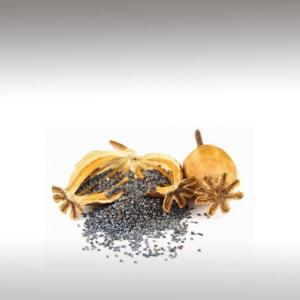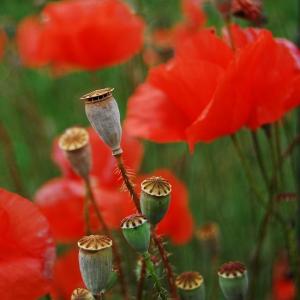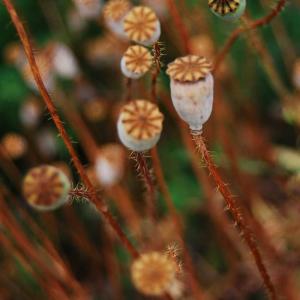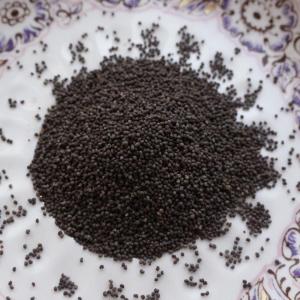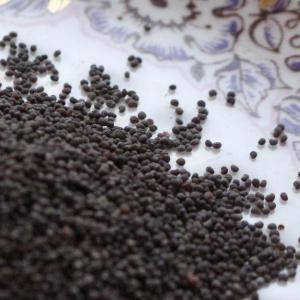
POPPY SEED OIL (PAPAVER SOMNIFERUM) - BASE OILS

BASE / GENERAL DATA
Information submited: June 2, 2015 Modified: May 9, 2018 By: OperaDreamhouse
While growing Poppies islegal, it is illegal to process what is grown into the drug form.
Poppyseed oil (also Poppy Seed oil, Poppy oil) is an edible oil from Poppy seeds (Seeds of Papaver Somniferum, the Opium Poppy). The oil has culinary and pharmaceutical uses, as well as long established uses in the making of paints, varnishes, and soaps.
Seventy to 100 different varieties of the Poppy exist. The Opium Poppy is a small annual, but other Poppy species may be annual, biennial, or perennial. The bright showy flowers of the genus Papaver range in color from white to deep reds and purples. The seeds of the plants vary in color from light cream to blue - black and are numerous and minutely pitted. Sap from the seed pods may be white, orange, or red.
Poppy Seed oil is a clear, light yellow oil with a pleasant smell.
The earliest accounts of the use of poppy preparations date to the ancient Sumerians in Mesopotamia, where the plant was used medicinally and was known as Hul Gil (the Plant of Joy).
Poppy Seed oil is a drying oil. In oil painting, it is a popular oil for binding pigment, thinning paint, and varnishing finished paintings. Poppy seed oil has been used for painting for at least 1500 years - one of the oldest known oil paintings, found in caves of Afghanistan and dated to AD 650, was likely drawn using Poppy seed oil.
An early 20th century industry manual states that while the Opium Poppy was grown extensively in Eurasia, most of the world production of Poppy seed oil occurred in France and Germany, from Poppy seeds imported from other countries.
From 1900 to 1911, France and Germany together produced on the order of 60,000,000 kilograms per year. At that time, poppyseed oil was used primarily to dress salads and frequently was adulterated with Sesame oil and Hazelnut oil to improve the taste of oil from stored (rancid) seeds.
Chenical strucutre:
Poppy seed oil is a carrier oil, having little or no odor and a pleasant taste. The primary aroma compound responsible for its flavor is 2 - pentylfuran, also present are the volatilecompounds 1 - pentanol, 1 -hexanal, 1 - hexanol, and caproic acid.
Poppy seeds yield 45 - 50% oil. Like Poppy seeds, Poppy Seed oil is highly palatable, high in Vitamin E.
Poppy Seed oil from one source has been reported to contain 30,9 mg gamma-tocopherol per 100 g. It also contains alphaand gamma tocotrienols, but not others. Compared to other vegetable oils, Poppy Seed oil has a moderate amount of phytosterols: higher than Soybean oil and Peanut oil, lower than Safflower oil, Sesame oil, Wheat Germ oil, Corn oil, and Rice Bran oil.
Sterols in Poppy Seed oil consist almost entirely of campesterol, stigmasterol, sitosterol and delta 5 - avenasterol.
Poppy seed oil is high in linoleic acid. Other triglycerides present in notable quantities are oleic acid and palmitic acid.
Poppyseed oil (also Poppy Seed oil, Poppy oil) is an edible oil from Poppy seeds (Seeds of Papaver Somniferum, the Opium Poppy). The oil has culinary and pharmaceutical uses, as well as long established uses in the making of paints, varnishes, and soaps.
Seventy to 100 different varieties of the Poppy exist. The Opium Poppy is a small annual, but other Poppy species may be annual, biennial, or perennial. The bright showy flowers of the genus Papaver range in color from white to deep reds and purples. The seeds of the plants vary in color from light cream to blue - black and are numerous and minutely pitted. Sap from the seed pods may be white, orange, or red.
Poppy Seed oil is a clear, light yellow oil with a pleasant smell.
The earliest accounts of the use of poppy preparations date to the ancient Sumerians in Mesopotamia, where the plant was used medicinally and was known as Hul Gil (the Plant of Joy).
Poppy Seed oil is a drying oil. In oil painting, it is a popular oil for binding pigment, thinning paint, and varnishing finished paintings. Poppy seed oil has been used for painting for at least 1500 years - one of the oldest known oil paintings, found in caves of Afghanistan and dated to AD 650, was likely drawn using Poppy seed oil.
An early 20th century industry manual states that while the Opium Poppy was grown extensively in Eurasia, most of the world production of Poppy seed oil occurred in France and Germany, from Poppy seeds imported from other countries.
From 1900 to 1911, France and Germany together produced on the order of 60,000,000 kilograms per year. At that time, poppyseed oil was used primarily to dress salads and frequently was adulterated with Sesame oil and Hazelnut oil to improve the taste of oil from stored (rancid) seeds.
Chenical strucutre:
Poppy seed oil is a carrier oil, having little or no odor and a pleasant taste. The primary aroma compound responsible for its flavor is 2 - pentylfuran, also present are the volatilecompounds 1 - pentanol, 1 -hexanal, 1 - hexanol, and caproic acid.
Poppy seeds yield 45 - 50% oil. Like Poppy seeds, Poppy Seed oil is highly palatable, high in Vitamin E.
Poppy Seed oil from one source has been reported to contain 30,9 mg gamma-tocopherol per 100 g. It also contains alphaand gamma tocotrienols, but not others. Compared to other vegetable oils, Poppy Seed oil has a moderate amount of phytosterols: higher than Soybean oil and Peanut oil, lower than Safflower oil, Sesame oil, Wheat Germ oil, Corn oil, and Rice Bran oil.
Sterols in Poppy Seed oil consist almost entirely of campesterol, stigmasterol, sitosterol and delta 5 - avenasterol.
Poppy seed oil is high in linoleic acid. Other triglycerides present in notable quantities are oleic acid and palmitic acid.

SPIRITUAL PRACTISES DATA

MEDICINE / HEALTH DATA

BEAUTY / COSMETICS DATA

FOOD / COOKING DATA
COMMENTS
No comments.


